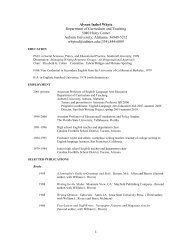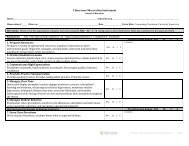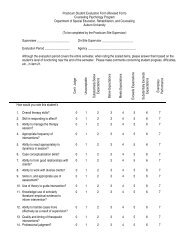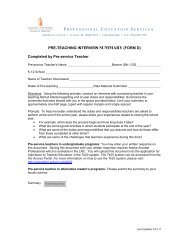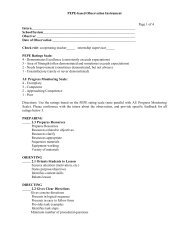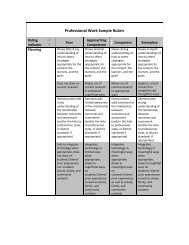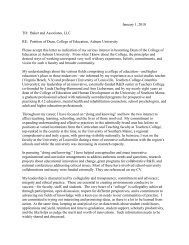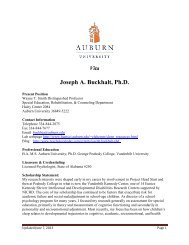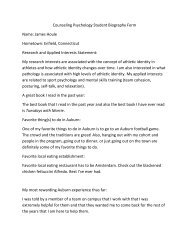8.0MB - College of Education - Auburn University
8.0MB - College of Education - Auburn University
8.0MB - College of Education - Auburn University
- No tags were found...
You also want an ePaper? Increase the reach of your titles
YUMPU automatically turns print PDFs into web optimized ePapers that Google loves.
TrackingAlabama’sHigh SchoolStudentsQ&A with Dr. Karen RabrenDr. Karen Rabren, associate pr<strong>of</strong>essor and director<strong>of</strong> the <strong>Auburn</strong> Transition Leadership Institute (ATLI),conducts research on transition programs and their postschooloutcomes. “Transition” refers to preparing highschool students with disabilities for young adult rolesand responsibilities. In recognition for her work in thisarea, Dr. Rabren received the college’s 2007 OutstandingFaculty Award for Research.Why study the outcomes?It is no longer enough to just provide quality curriculaand programs in high school, with the hope theirdesired objectives are met. Rather than relying on promisesalone, we must be accountable. We need to makeimprovements based on outcomes.What information are youlooking for?We are hoping to learn if former students are working,or if they are receiving further training or education.What about their quality <strong>of</strong> life? We want to identify the postschoolproblems so, wherever possible, they may be minimizedthrough improved high school programs and services.How do you assess theseoutcomes?In 1996, we developed the Alabama Student Tracking Systemand implemented it annually until 2006. During the past11 years, we have obtained information from almost 17,000Alabama high school students with disabilities. Through theleadership <strong>of</strong> Dr. W. Mabrey Whetstone Jr., director <strong>of</strong> specialeducation services in Alabama’s State Department <strong>of</strong> <strong>Education</strong>,Alabama has emerged as a leader in the tracking <strong>of</strong> studentoutcome data collection.What is happening now?The Alabama Student Tracking System became the foundationfor new commercial s<strong>of</strong>tware application—the Post-School Outcomes Data System (P.O.D.S.). This Web-baseddata-collection system, developed by the <strong>Auburn</strong> TransitionLeadership Institute, was copyrighted in March 2006 with thehelp <strong>of</strong> <strong>Auburn</strong> <strong>University</strong>’s Office <strong>of</strong> Technology Transfer.First licensed to Pennsylvania in 2006, P.O.D.S. assisted in collectingoutcome data from nearly 4,000 high school studentsexiting 125 <strong>of</strong> its 500 school districts.How does P.O.D.S. work?Using this online s<strong>of</strong>tware, school systems can log in andenter demographic data from students prior to their exit fromschool. One year later, school personnel contact the formerRabren (left) and Eaves (center) discuss transition and alumni with departstudents and gather post-school outcome information. Studentresponses are entered into the Web data bank and storedfor dynamic-report generation. The school systems receive anonline report soon after the information is obtained from theformer students. The report uses bar graphs to compare thelocal school results with statewide results.For more information about P.O.D.S. or the other efforts bythe <strong>Auburn</strong> Transition Leadership Institute, visiteducation.auburn.edu/rse/instituteKelly BrumbeloeProject Director20 Building A Better Future for All education.auburn.edu




